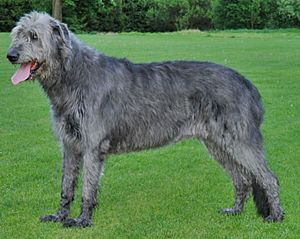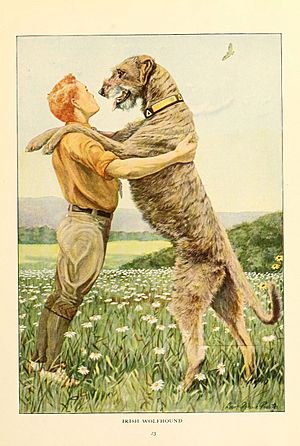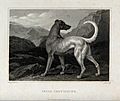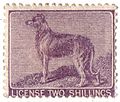Irish wolfhound facts for kids
 |
||||||||||||||||||||||||||
| Origin | Ireland | |||||||||||||||||||||||||
|---|---|---|---|---|---|---|---|---|---|---|---|---|---|---|---|---|---|---|---|---|---|---|---|---|---|---|
|
||||||||||||||||||||||||||
| Notes | National animal of Ireland | |||||||||||||||||||||||||
| Domestic dog (Canis lupus familiaris) | ||||||||||||||||||||||||||
The Irish Wolfhound is a very old and large dog breed from Ireland. It is a type of sighthound, which means it hunts mostly by seeing its prey, not by smell.
These dogs are famous for their huge size and strong looks. They have inspired many stories, poems, and myths. Long ago, Irish Wolfhounds were used to hunt fast animals. They were also known as great guard dogs, especially for protecting people from wolves.
Contents
History of the Irish Wolfhound
Ancient Times to the 1800s
The Irish Wolfhound has a very long history. In 391 AD, a Roman leader named Quintus Aurelius Symmachus received seven "canes Scotici" as a gift. These were large dogs from Ireland, used to fight lions and bears. People in Rome were amazed by them! "Scoti" was a Latin name for the ancient Irish people.
People believe these dogs are very old. The ancient Irish, called Gaels, used wolfhounds for hunting. Dogs are mentioned in old Irish laws and stories from as far back as the 6th century. The Irish word "Cú" means "hound" or "dog." It was often added to the names of brave warriors and kings to show respect. For example, the legendary hero Cú Chulainn means "hound of Culann." He got this name after he killed a fierce guard dog and offered to take its place.
Some experts believe that the dogs from ancient times were not as big as today's Irish Wolfhounds. They think the dogs of Cú Chulainn were probably closer to the size of a German Shepherd.
Hunting dogs were highly valued. They were often given as gifts to important people and leaders from other countries. Around 1210, King John of England gave an Irish hound named Gelert to Llewellyn, a prince of Wales. A poet later wrote a famous poem about Gelert.
In 1571, a writer named Edmund Champion described the hounds used to hunt wolves in Ireland. He said they were "bigger of bone and limb than a colt" (a young horse). Because these dogs were so popular, many were sent to royal families in Europe. This meant there were fewer wolfhounds left in Ireland. To make sure enough dogs remained to control the wolf population, Oliver Cromwell made a rule in 1652 that limited how many could be exported.
An old picture from 1738 by Johann Elias Ridinger shows what the original wolfdog looked like. In the 1700s, people wrote about the Irish Wolfhound's huge size, strength, and how it looked like a Greyhound. They said it was the biggest and most beautiful type of dog, often about 36 inches tall. They were described as gentle and peaceful, but very strong.
The last wolf in Ireland was killed in 1786. It was thought to be killed by a group of wolfdogs. After this, the wolfhounds were no longer needed for hunting wolves. They became symbols of importance for a few families.
Appearance of the Irish Wolfhound
The Irish Wolfhound is known as the tallest of all dog breeds. They look very powerful and impressive. These dogs combine strength and speed with excellent eyesight. They are the biggest and tallest of the "galloping hounds."
An Irish Wolfhound looks like a rough-coated Greyhound. They are very muscular and strong, but also built gracefully. They move easily and actively, holding their head and neck high. Their tail usually curves slightly upwards. An Irish Wolfhound should be taller than a Great Dane. However, they are not the heaviest breed. Their body shape is like a Greyhound, with a wide, deep chest and a tucked-up belly.
Their fur can be grey, brindle (striped), red, black, white, fawn, or wheaten (pale yellow).
Irish Wolfhounds were bred to hunt alone over long distances. They relied on their sight to find prey. This is why their neck should be long, and they usually hold their head high. They should also look longer than they are tall. Their body is built to be "fast enough to catch a wolf, and strong enough to kill it."
For male Irish Wolfhounds, the minimum height is about 32 inches (81 cm), and the minimum weight is about 120 pounds (54 kg). For females, the minimum height is about 30 inches (76 cm), and the minimum weight is about 105 pounds (48 kg). Many female wolfhounds today are taller than the minimum.
Temperament of the Irish Wolfhound
Irish Wolfhounds have unique personalities. They are often known for being calm and quiet, especially inside the house. Despite their large size, they are usually not destructive or overly playful indoors. This is because they are generally smart, thoughtful, and a bit reserved.
These dogs form strong bonds with their families. If they are left alone for too long, they can become sad or destructive. An Irish Wolfhound is not a typical "guard dog" that barks at strangers. Instead, they protect the people they love rather than just a house or belongings. They get very attached to their owners and other dogs they grow up with.
Because they were bred to hunt independently, they might not always wait for commands. They are also not usually aggressive towards other dogs. However, when they play, they might "course" (chase) another dog. This is a natural hunting behavior, not a fight. Most Wolfhounds are very gentle with children.
Irish Wolfhounds are fairly easy to train. They respond well to clear, gentle, and steady guidance. They are loved for being loyal, loving, patient, and devoted. While their size can scare some people away, they are usually friendly to strangers. But if they or their family are in danger, they are very brave and will protect them. They are very sensitive to bad intentions, which makes them excellent guardians.
Images for kids
-
Irish Greyhound in a mountainous landscape (1804), by Philip Reinagle.
-
Champion Irish Wolfhound ’Patrick of Ifold’ at the Ulster Museum.
-
Wolf hunt by Jean-Baptiste Oudry, showing a wolf attacked by wolfhounds and mastiffs.
See also
 In Spanish: Lobero irlandés para niños
In Spanish: Lobero irlandés para niños
















